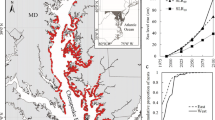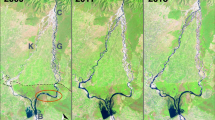Abstract
The range expansion of exotic plant species, including the invasive reed Phragmites australis, causes widespread structural and functional changes to coastal ecosystems along the Atlantic and Gulf Coasts of North America. Native estuarine species, such as the diamondback terrapin (Malaclemys terrapin), are at risk of adverse effects from rapid habitat changes due to exotic invasions. Diamondback terrapins currently face population threats including by-catch mortality in crab pots, predation, and habitat loss, and populations may continue to suffer if deleterious plant invasions into preferred nesting habitats are left unchecked. We examined the extent to which Phragmites affects nesting of a breeding population of diamondback terrapins at Fisherman Island National Wildlife Refuge on the eastern shore of Virginia, where Phragmites has recently expanded into known areas of terrapin nesting. With data collected from the 2015 nesting season, we quantified the extent to which Phragmites shading could impact nest incubation temperature and determined how Phragmites density impacts the risk of rhizome invasion into nests. We conclude that Phragmites cover greater than 50% would decrease incubation temperatures of terrapin nests sufficiently to produce predominantly male hatchlings. Phragmites cover had no observed effect on root growth into simulated nests, but cover by other dune plant species explained observed trends in root growth. These results suggest that terrapins may be negatively impacted by Phragmites expansion into open nesting sites. Breeding site fidelity exhibited by terrapins and other estuarine species could limit the ability of their populations to adjust to rapid coastal expansion of invasive plant species.





Similar content being viewed by others
References
Ailstock, M.S., C.M. Norman, and P.J. Bushmann. 2001. Common reed Phragmites australis: control and effects upon biodiversity in freshwater nontidal wetlands. Restoration Ecology 9: 49–59.
Baldwin, J.D., L.A. Latino, B.K. Mealey, G.M. Parks, and M.R.J. Forstner. 2005. The diamondback terrapin in Florida Bay and the Florida Keys: insights into turtle conservation and ecology. Amphibians and reptiles: status and conservation in Florida, 180–186. Florida: Krieger Publishing Company.
Benoit, L.K., and R.A. Askins. 1999. Impact of the spread of Phragmites on the distribution of birds in Connecticut tidal marshes. Wetlands 19: 194–208.
Bolton, R.M., and R.J. Brooks. 2010. Impact of the seasonal invasion of Phragmites australis (common reed) on turtle reproductive success. Chelonian Conservation Biology 9: 238–243.
Bouchard, S.S., and K.A. Bjorndal. 2000. Sea turtles as biological transporters of nutrients and energy from marine to terrestrial ecosystems. Ecology 81: 2305–2313.
Burger, J. 1977. Determinants of hatching success in diamondback terrapin, Malaclemys terrapin. American Midland Naturalist 97: 444–464.
Burger, J., and W.A. Montevecchi. 1975. Nest site selection in the terrapin Malaclemys terrapin. Copeia 1: 113–119.
Burke, R.L., and A.M. Calichio. 2014. Temperature-dependent sex determination in the diamond-backed terrapin (Malaclemys terrapin). Journal of Herpetology 48: 466–470.
Burke, R.L., C.M. Schneider, and M.T. Dolinger. 2005. Cues used by raccoons to find turtle nests: effects of flags, human scent, and diamond-backed terrapin sign. Journal of Herpetology 39: 312–315.
Butler, J.A., C. Broadhurst, M. Green, and Z. Mullin. 2004. Nesting, nest predation and hatchling emergence of the Carolina diamondback terrapin, Malaclemys terrapin centrata, in northeastern Florida. American Midland Naturalist 152: 145–155.
Butler, J.A., R.A. Seigel, and B.K. Mealey. 2006. Malaclemys terrapin—diamondback terrapin. Chelonian Research Monographs 3: 279–295.
Carr, A.F. 1952. Handbook of turtles. The turtles of the United States, Canada, and Baja California, 542 pp. New York: Cornell University Press.
Chambers, R.M., L.A. Meyerson, and K. Saltonstall. 1999. Expansion of Phragmites australis into tidal wetlands of North America. Aquatic Botany 64: 261–273.
Dibble, K.L., P.S. Pooler, and L.A. Meyerson. 2013. Impacts of plant invasions can be reversed through restoration: a regional meta-analysis of faunal communities. Biological Invasions 15: 1725–1737.
Didham, R.K., J.M. Tylianakis, N.J. Gemmell, T.A. Rand, and R.M. Ewers. 2007. Interactive effects of habitat modification and species invasion on native species decline. Trends in Ecology & Evolution 22: 489–496.
Draud, M., M. Bossert, and S. Zimnavoda. 2004. Predation on hatchling and juvenile diamondback terrapins (Malaclemys terrapin) by the Norway rat (Rattus norvegicus). Journal of Herpetology 38: 467–470.
Ernst, C.H., J.E. Lovich, and R.W. Barbour. 2009. Turtles of the United States and Canada, 578 pp. Washington: Smithsonian Institution Press.
Feinberg, J.A., and R.L. Burke. 2003. Nesting ecology and predation of diamondback terrapins, Malaclemys terrapin, at Gateway National Recreation Area, New York. Journal of Herpetology 37: 517–526.
Freedberg, S., and M.J. Wade. 2001. Cultural inheritance as a mechanism for population sex-ratio bias in reptiles. Evolution 55: 1049–1055.
Galatowitsch, S.M., N.O. Anderson, and P.D. Ascher. 1999. Invasiveness in wetland plants in temperate North America. Wetlands 19: 733–755.
Gibbons, J.W., and D.H. Nelson. 1978. The evolutionary significance of delayed emergence from the nest by hatchling turtles. Evolution 32: 297–303.
Gibbons, J.W., J. Lovich, A. Tucker, N. FitzSimmons, and J. Greene. 2001. Demographic and ecological factors affecting conservation and management of the diamondback terrapin (Malaclemys terrapin) in South Carolina. Chelonian Conservation and Biology 4: 66–74.
Greenberg, D.A., and D.M. Green. 2013. Effects of an invasive plant on population dynamics in toads. Conservation Biology 27: 1049–1057.
Grosse, A.M., B.A. Crawford, J.C. Maerz, K.A. Buhlmann, T. Norton, M. Kaylor, and T.D. Tuberville. 2014. Effects of vegetation structure and artificial nesting habitats on hatchling sex determination and nest survival of diamondback terrapins. Journal of Fish and Wildlife Management 6: 19–28.
Hackney, A.D., R.F. Baldwin, and P.G.R. Jodice. 2013. Mapping risk for nest predation on a barrier island. Journal of Coastal Conservation 17: 615–621.
Jeyasuria, P., W.M. Roosenburg, and A.R. Place. 1994. Role of P-450 aromatase in sex determination of the diamondback terrapin, Malaclemys terrapin. Journal of Experimental Zoology 270: 95–111.
Lazell, J.D.J., and P.J. Auger. 1981. Predation on diamondback terrapin (Malaclemys terrapin) eggs by dunegrass (Ammophila breviligulata). Copeia 3: 723–724.
Lovich, J.E., and J.W. Gibbons. 1990. Age at maturity influences adult sex ratio in the turtle Malaclemys terrapin. Oikos 59: 126–134.
Martin, L.J., and B. Blossey. 2013. The runaway weed: costs and failures of Phragmites australis management in the USA. Estuaries and Coasts 36: 626–632.
Meyerson, L.A., K. Saltonstall, L. Windham, E. Kiviat, and S. Findlay. 2000. A comparison of Phragmites australis in freshwater and brackish marsh environments in North America. Wetlands Ecology and Management 8: 89–103.
Mrosovsky, N., and C. Pieau. 1991. Transitional range of temperature, pivotal temperatures and thermosensitive stages for sex determination in reptiles. Amphibia-Reptilia 12: 169–179.
Rice, D., J. Rooth, and J. Court Stevenson. 2000. Colonization and expansion of Phragmites australis in upper Chesapeake Bay tidal marshes. Wetlands 20: 280–299.
Roman, C.T. 1978. Tidal restriction: its impact on the vegetation of six Connecticut coastal marshes. Master’s thesis. New London: Connecticut College.
Roosenburg, W.M. 1994. Nesting habitat requirements of the diamondback terrapin: a geographic comparison. Wetlands Journal 6: 9–12.
Roosenburg, W.M. (2004). The impact of crab pot fisheries on terrapin (Malaclemys terrapin) populations: where are we and where do we need to go. In Conservation and ecology of turtles of the mid-Atlantic region: a symposium, Salt Lake City, UT, pp. 23–30.
Roosenburg, W.M., D.M. Spontak, S.P. Sullivan, E.L. Matthews, M.L. Heckman, R.J. Trimbath, R.P. Dunn, E.A. Dustman, L. Smith, and L.J. Graham. 2014. Nesting habitat creation enhances recruitment in a predator-free environment: Malaclemys nesting at the Paul S. Sarbanes Ecosystem Restoration Project. Restoration Ecology 22: 815–823.
Ruzicka, V. (2006). The influence of predation on the nesting ecology of diamondback terrapins (Malaclemys terrapin) in the lower Chesapeake Bay. Master’s thesis. Williamsburg: College of William and Mary.
Seigel, R.A. 1980. Nesting habits of diamondback terrapins (Malaclemys terrapin) on the Atlantic coast of Florida. Transactions of the Kansas Academy of Science 83: 239–246.
Silliman, B.R., and M.D. Bertness. 2004. Shoreline development drives invasion of Phragmites australis and the loss of plant diversity on New England salt marshes. Conservation Biology 18: 1424–1434.
Steingrobe, B., H. Schmid, and N. Claassen. 2001. The use of the ingrowth core method for measuring root production of arable crops—influence of soil and root disturbance during installation of the bags on root ingrowth into the cores. European Journal of Agronomy 15: 143–151.
Uddin, N., R.W. Robinson, D. Caridi, and A.Y.A. Harun. 2014. Suppression of native Melaleuca ericifolia by the invasive Phragmites australis through allelopathic root exudates. American Journal of Botany 101: 479–487.
Wilcove, D.S., D. Rothstein, J. Dubow, A. Phillips, and E. Losos. 1998. Quantifying threats to imperiled species in the United States. Bioscience 48: 607–615.
Zedler, J.B., and S. Kercher. 2004. Causes and consequences of invasive plants in wetlands: opportunities, opportunists, and outcomes. Critical Reviews in Plant Sciences 23: 431–452.
Acknowledgements
The authors would like to thank the U.S. Fish and Wildlife Service at the Eastern Shore of Virginia NWR for the opportunity to perform field work on the Refuge; Amanda Hackney, Margarete Walden, and Andrew Grosse for project specific information and data to assist with project development; Timothy Russell, Drew Lamar, Matthias Leu from the College of William and Mary for logistical support and review; and the multiple funding resources that made this project possible, including the Virginia Herpetological Society, the Diamondback Terrapin Working Group, and the Office of Graduate Studies at William and Mary.
Author information
Authors and Affiliations
Corresponding author
Additional information
Communicated by Matthew D. Taylor
Rights and permissions
About this article
Cite this article
Cook, C.E., McCluskey, A.M. & Chambers, R.M. Impacts of Invasive Phragmites australis on Diamondback Terrapin Nesting in Chesapeake Bay. Estuaries and Coasts 41, 966–973 (2018). https://doi.org/10.1007/s12237-017-0325-z
Received:
Revised:
Accepted:
Published:
Issue Date:
DOI: https://doi.org/10.1007/s12237-017-0325-z




